Auditing Assignment HA3032: Materiality, Audit Risk, and Opinions
VerifiedAdded on 2022/11/24
|8
|2288
|365
Homework Assignment
AI Summary
This assignment solution addresses core concepts in auditing, starting with the definition and significance of materiality and its inverse relationship with audit risk. It then explains how auditors assess control risk, influencing the audit program and the extent of evidence gathered. The role and purpose of management representation letters are discussed, including the implications of refusal to provide one. The solution also explores various methods of collecting audit evidence and defines subsequent events, detailing procedures for their review. Finally, the assignment analyzes different audit opinion scenarios, including disclaimer, adverse, and qualified opinions, based on specific case studies. This comprehensive approach provides a solid understanding of key auditing principles and practices, offering a valuable resource for students studying auditing.
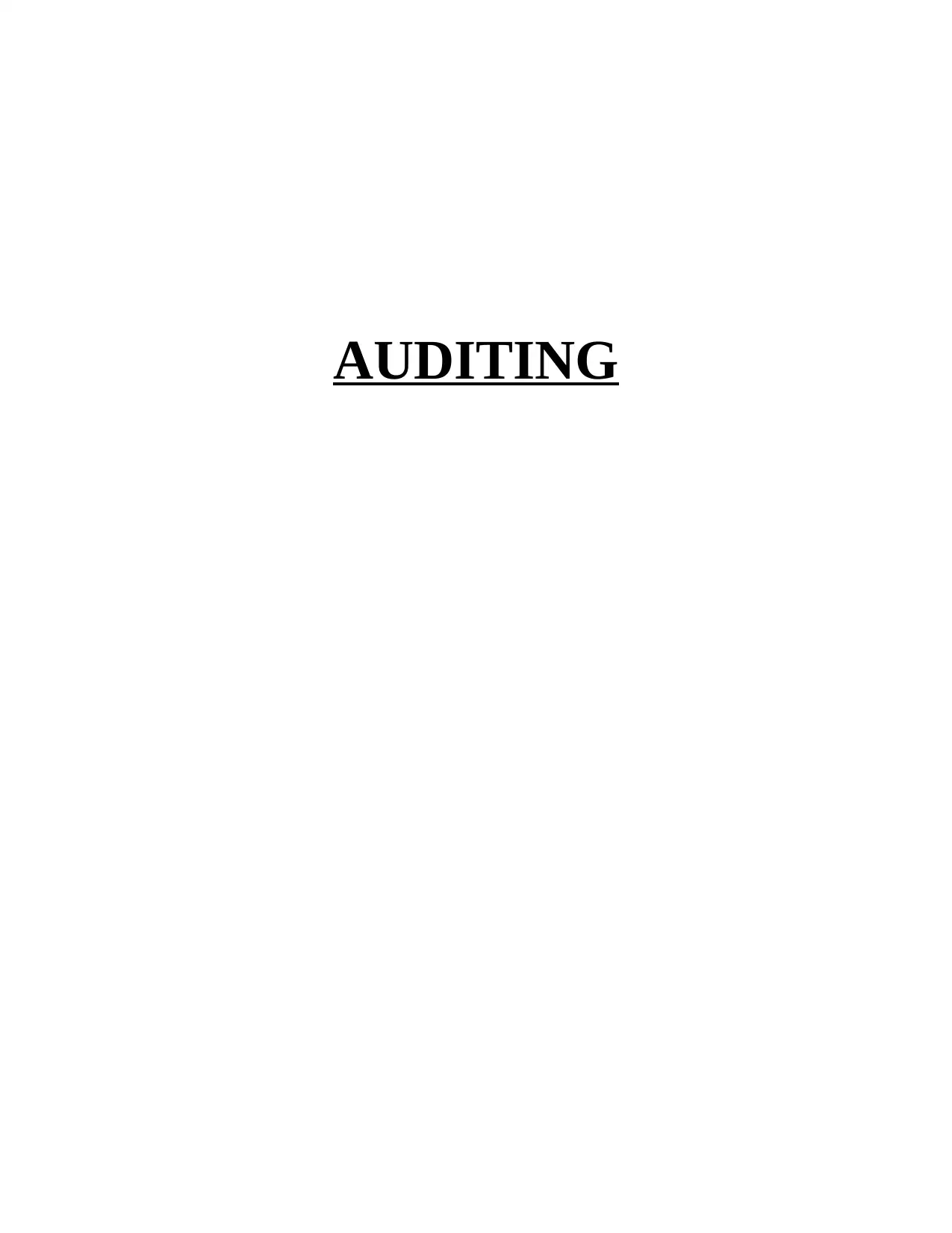
AUDITING
Paraphrase This Document
Need a fresh take? Get an instant paraphrase of this document with our AI Paraphraser
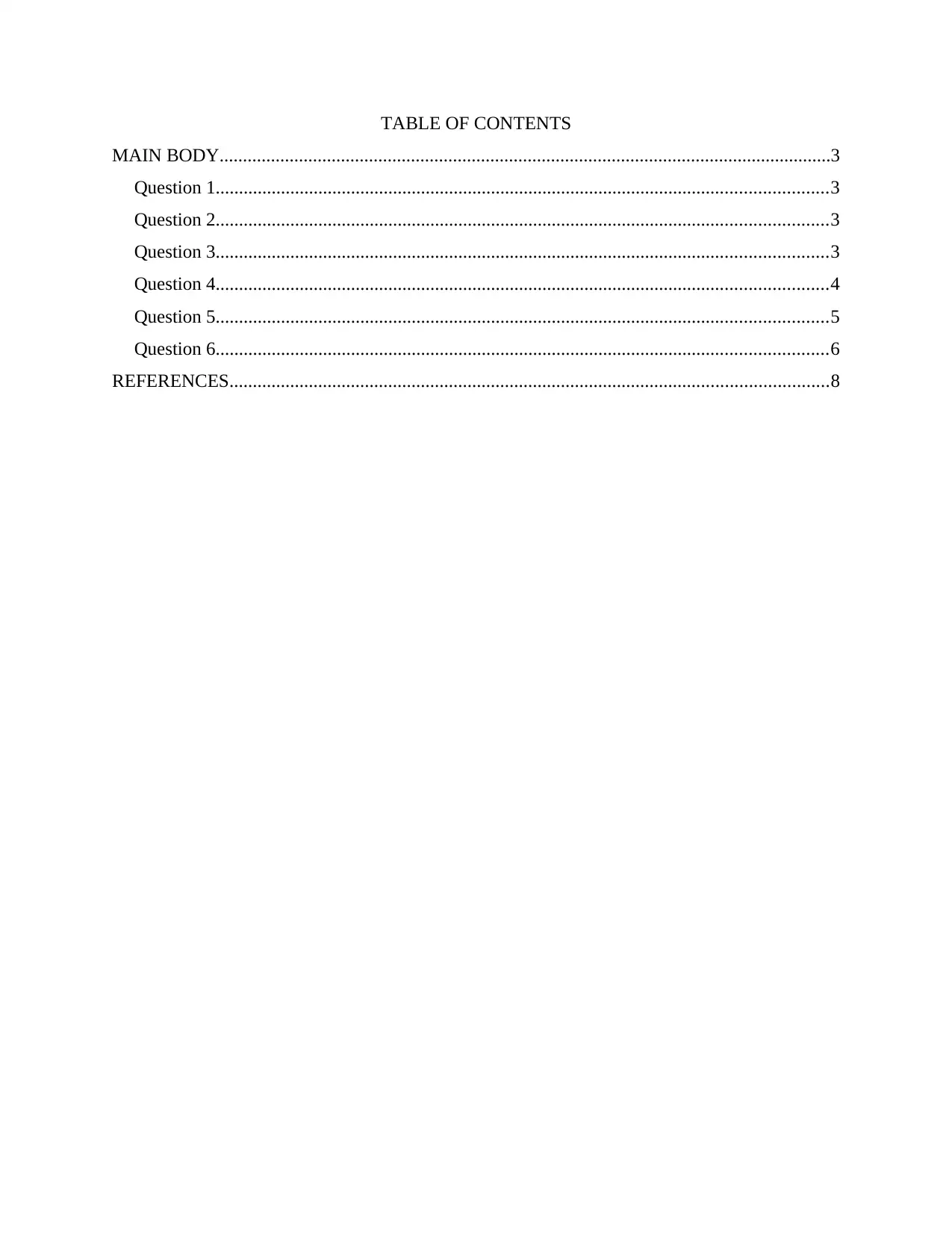
TABLE OF CONTENTS
MAIN BODY...................................................................................................................................3
Question 1...................................................................................................................................3
Question 2...................................................................................................................................3
Question 3...................................................................................................................................3
Question 4...................................................................................................................................4
Question 5...................................................................................................................................5
Question 6...................................................................................................................................6
REFERENCES................................................................................................................................8
MAIN BODY...................................................................................................................................3
Question 1...................................................................................................................................3
Question 2...................................................................................................................................3
Question 3...................................................................................................................................3
Question 4...................................................................................................................................4
Question 5...................................................................................................................................5
Question 6...................................................................................................................................6
REFERENCES................................................................................................................................8
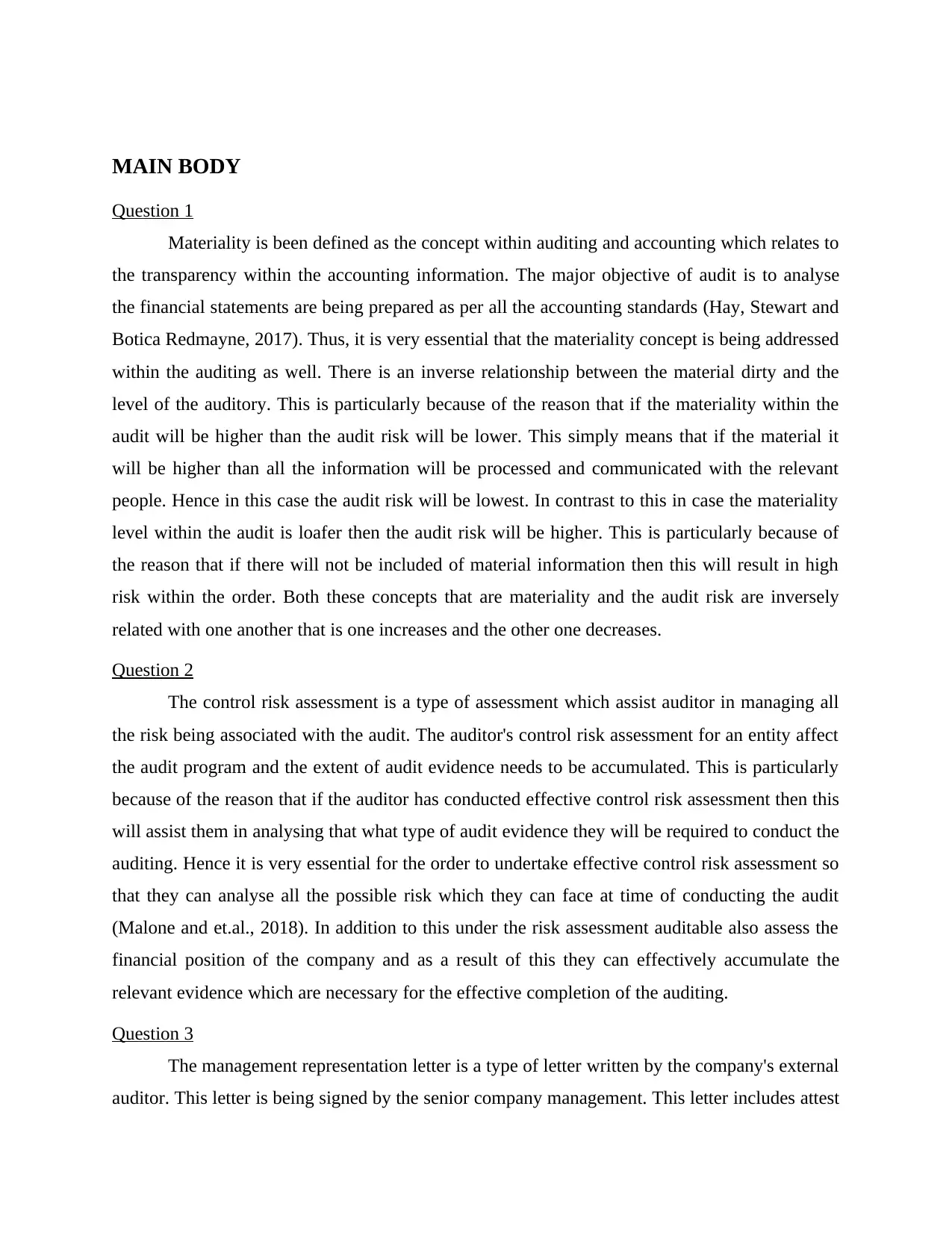
MAIN BODY
Question 1
Materiality is been defined as the concept within auditing and accounting which relates to
the transparency within the accounting information. The major objective of audit is to analyse
the financial statements are being prepared as per all the accounting standards (Hay, Stewart and
Botica Redmayne, 2017). Thus, it is very essential that the materiality concept is being addressed
within the auditing as well. There is an inverse relationship between the material dirty and the
level of the auditory. This is particularly because of the reason that if the materiality within the
audit will be higher than the audit risk will be lower. This simply means that if the material it
will be higher than all the information will be processed and communicated with the relevant
people. Hence in this case the audit risk will be lowest. In contrast to this in case the materiality
level within the audit is loafer then the audit risk will be higher. This is particularly because of
the reason that if there will not be included of material information then this will result in high
risk within the order. Both these concepts that are materiality and the audit risk are inversely
related with one another that is one increases and the other one decreases.
Question 2
The control risk assessment is a type of assessment which assist auditor in managing all
the risk being associated with the audit. The auditor's control risk assessment for an entity affect
the audit program and the extent of audit evidence needs to be accumulated. This is particularly
because of the reason that if the auditor has conducted effective control risk assessment then this
will assist them in analysing that what type of audit evidence they will be required to conduct the
auditing. Hence it is very essential for the order to undertake effective control risk assessment so
that they can analyse all the possible risk which they can face at time of conducting the audit
(Malone and et.al., 2018). In addition to this under the risk assessment auditable also assess the
financial position of the company and as a result of this they can effectively accumulate the
relevant evidence which are necessary for the effective completion of the auditing.
Question 3
The management representation letter is a type of letter written by the company's external
auditor. This letter is being signed by the senior company management. This letter includes attest
Question 1
Materiality is been defined as the concept within auditing and accounting which relates to
the transparency within the accounting information. The major objective of audit is to analyse
the financial statements are being prepared as per all the accounting standards (Hay, Stewart and
Botica Redmayne, 2017). Thus, it is very essential that the materiality concept is being addressed
within the auditing as well. There is an inverse relationship between the material dirty and the
level of the auditory. This is particularly because of the reason that if the materiality within the
audit will be higher than the audit risk will be lower. This simply means that if the material it
will be higher than all the information will be processed and communicated with the relevant
people. Hence in this case the audit risk will be lowest. In contrast to this in case the materiality
level within the audit is loafer then the audit risk will be higher. This is particularly because of
the reason that if there will not be included of material information then this will result in high
risk within the order. Both these concepts that are materiality and the audit risk are inversely
related with one another that is one increases and the other one decreases.
Question 2
The control risk assessment is a type of assessment which assist auditor in managing all
the risk being associated with the audit. The auditor's control risk assessment for an entity affect
the audit program and the extent of audit evidence needs to be accumulated. This is particularly
because of the reason that if the auditor has conducted effective control risk assessment then this
will assist them in analysing that what type of audit evidence they will be required to conduct the
auditing. Hence it is very essential for the order to undertake effective control risk assessment so
that they can analyse all the possible risk which they can face at time of conducting the audit
(Malone and et.al., 2018). In addition to this under the risk assessment auditable also assess the
financial position of the company and as a result of this they can effectively accumulate the
relevant evidence which are necessary for the effective completion of the auditing.
Question 3
The management representation letter is a type of letter written by the company's external
auditor. This letter is being signed by the senior company management. This letter includes attest
⊘ This is a preview!⊘
Do you want full access?
Subscribe today to unlock all pages.

Trusted by 1+ million students worldwide

to the accuracy of the financial statements that is the company has provided all the relevant
information to the auditors for their analysis (Byrne, Anda and Ho, 2019). The top management
that is the CEO and CFO are usually required to sign this letter. This letter is being signed after
the completion of ordered field work and before the time financial statements are being issued
along with the auditor's opinion. The main purpose of the representation letter is the written
confirmation from the management to the auditor relating to the fairness of the financial
statement elements for stop the major purpose of this letter is to emphasize the financial
statements of management representation and it includes the primary responsibility of accuracy
by the management only. Further in case when management refuses to issue the letter of
representation then it means that they are not willing to stand there verbal representation when
asked to do in writing. Under this case of management refusal to sign the representation letter it
is considered the scope limitation that results in a disclaimer report.
Question 4
Audit evidence is been defined as the information which the auditor of company collected from
the company for which auditing is being undertaken. this is a part of auditing work for review
and verifying the company's financial transactions and internal control so that the auditor can
ensure that whether the proper compliance with financial standards has been taken place or not.
Hence the different ways of collecting audit evidence are as follows-
1. Physical examination - this is a type of order to wear in the order to inspect the effect
physically and counts them whenever they require. This evidence is generally collected
variable possible based on the nature of the audit required. Example of this type of
evidence of training method is going to the premises and checking the premises.
2. Documentation- this is another type of method where in the auditor collect the written
documents like the vouchers purchase and voice and other related documents containing
the accounts of the company (Audit evidence, 2021). These evidences are more reliable
for ensuring that the audit has taken place in proper manner. The major example of this is
use of vouchers in sales invoice policy documents and others.
3. Analytical procedures- this is another type of method which is derived for acquiring the
data and to know the correctness of the various information. This involves examples like
using the comparison of the calculations and relationship between various data being
collected by the auditor (Senge, 2017).
information to the auditors for their analysis (Byrne, Anda and Ho, 2019). The top management
that is the CEO and CFO are usually required to sign this letter. This letter is being signed after
the completion of ordered field work and before the time financial statements are being issued
along with the auditor's opinion. The main purpose of the representation letter is the written
confirmation from the management to the auditor relating to the fairness of the financial
statement elements for stop the major purpose of this letter is to emphasize the financial
statements of management representation and it includes the primary responsibility of accuracy
by the management only. Further in case when management refuses to issue the letter of
representation then it means that they are not willing to stand there verbal representation when
asked to do in writing. Under this case of management refusal to sign the representation letter it
is considered the scope limitation that results in a disclaimer report.
Question 4
Audit evidence is been defined as the information which the auditor of company collected from
the company for which auditing is being undertaken. this is a part of auditing work for review
and verifying the company's financial transactions and internal control so that the auditor can
ensure that whether the proper compliance with financial standards has been taken place or not.
Hence the different ways of collecting audit evidence are as follows-
1. Physical examination - this is a type of order to wear in the order to inspect the effect
physically and counts them whenever they require. This evidence is generally collected
variable possible based on the nature of the audit required. Example of this type of
evidence of training method is going to the premises and checking the premises.
2. Documentation- this is another type of method where in the auditor collect the written
documents like the vouchers purchase and voice and other related documents containing
the accounts of the company (Audit evidence, 2021). These evidences are more reliable
for ensuring that the audit has taken place in proper manner. The major example of this is
use of vouchers in sales invoice policy documents and others.
3. Analytical procedures- this is another type of method which is derived for acquiring the
data and to know the correctness of the various information. This involves examples like
using the comparison of the calculations and relationship between various data being
collected by the auditor (Senge, 2017).
Paraphrase This Document
Need a fresh take? Get an instant paraphrase of this document with our AI Paraphraser
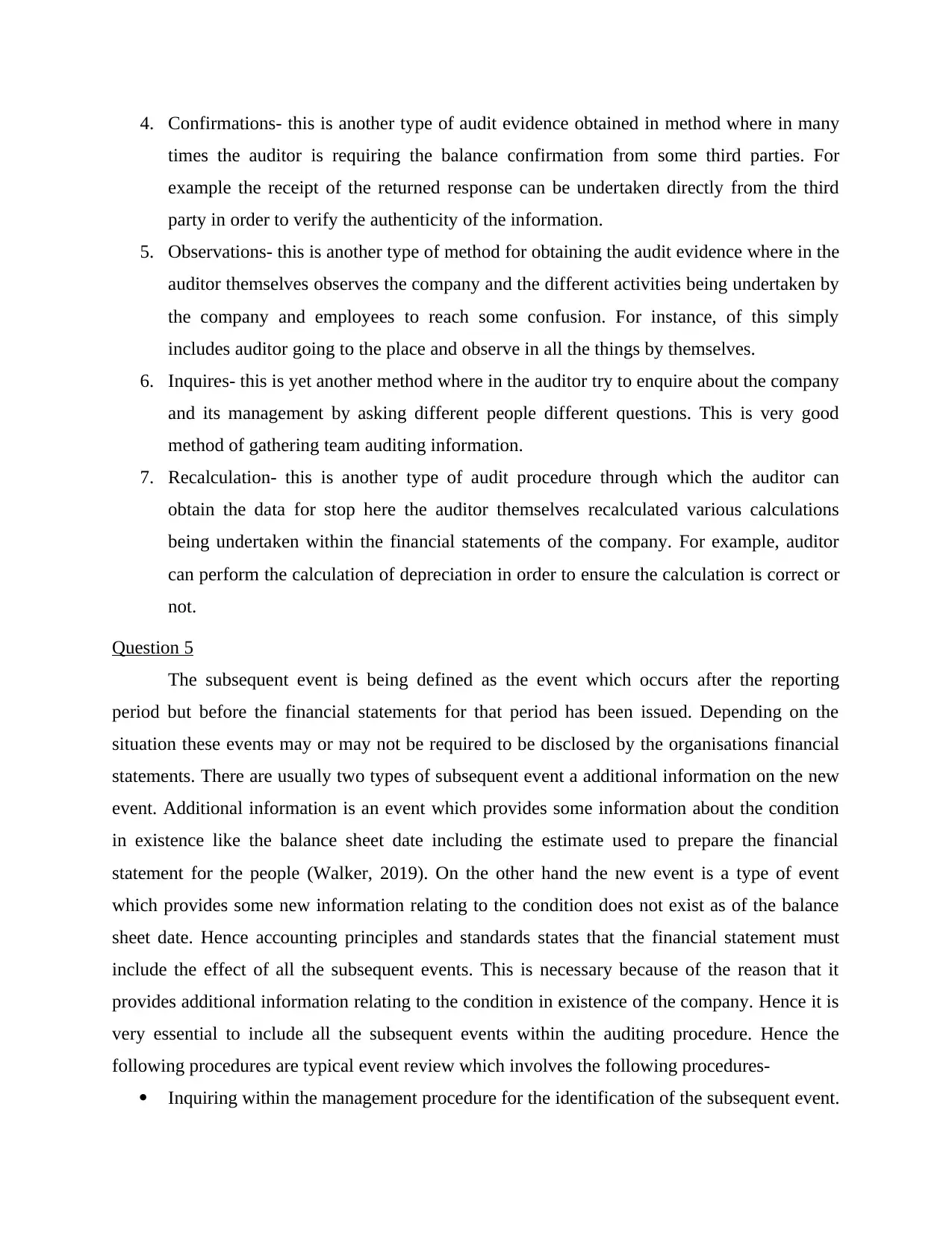
4. Confirmations- this is another type of audit evidence obtained in method where in many
times the auditor is requiring the balance confirmation from some third parties. For
example the receipt of the returned response can be undertaken directly from the third
party in order to verify the authenticity of the information.
5. Observations- this is another type of method for obtaining the audit evidence where in the
auditor themselves observes the company and the different activities being undertaken by
the company and employees to reach some confusion. For instance, of this simply
includes auditor going to the place and observe in all the things by themselves.
6. Inquires- this is yet another method where in the auditor try to enquire about the company
and its management by asking different people different questions. This is very good
method of gathering team auditing information.
7. Recalculation- this is another type of audit procedure through which the auditor can
obtain the data for stop here the auditor themselves recalculated various calculations
being undertaken within the financial statements of the company. For example, auditor
can perform the calculation of depreciation in order to ensure the calculation is correct or
not.
Question 5
The subsequent event is being defined as the event which occurs after the reporting
period but before the financial statements for that period has been issued. Depending on the
situation these events may or may not be required to be disclosed by the organisations financial
statements. There are usually two types of subsequent event a additional information on the new
event. Additional information is an event which provides some information about the condition
in existence like the balance sheet date including the estimate used to prepare the financial
statement for the people (Walker, 2019). On the other hand the new event is a type of event
which provides some new information relating to the condition does not exist as of the balance
sheet date. Hence accounting principles and standards states that the financial statement must
include the effect of all the subsequent events. This is necessary because of the reason that it
provides additional information relating to the condition in existence of the company. Hence it is
very essential to include all the subsequent events within the auditing procedure. Hence the
following procedures are typical event review which involves the following procedures-
Inquiring within the management procedure for the identification of the subsequent event.
times the auditor is requiring the balance confirmation from some third parties. For
example the receipt of the returned response can be undertaken directly from the third
party in order to verify the authenticity of the information.
5. Observations- this is another type of method for obtaining the audit evidence where in the
auditor themselves observes the company and the different activities being undertaken by
the company and employees to reach some confusion. For instance, of this simply
includes auditor going to the place and observe in all the things by themselves.
6. Inquires- this is yet another method where in the auditor try to enquire about the company
and its management by asking different people different questions. This is very good
method of gathering team auditing information.
7. Recalculation- this is another type of audit procedure through which the auditor can
obtain the data for stop here the auditor themselves recalculated various calculations
being undertaken within the financial statements of the company. For example, auditor
can perform the calculation of depreciation in order to ensure the calculation is correct or
not.
Question 5
The subsequent event is being defined as the event which occurs after the reporting
period but before the financial statements for that period has been issued. Depending on the
situation these events may or may not be required to be disclosed by the organisations financial
statements. There are usually two types of subsequent event a additional information on the new
event. Additional information is an event which provides some information about the condition
in existence like the balance sheet date including the estimate used to prepare the financial
statement for the people (Walker, 2019). On the other hand the new event is a type of event
which provides some new information relating to the condition does not exist as of the balance
sheet date. Hence accounting principles and standards states that the financial statement must
include the effect of all the subsequent events. This is necessary because of the reason that it
provides additional information relating to the condition in existence of the company. Hence it is
very essential to include all the subsequent events within the auditing procedure. Hence the
following procedures are typical event review which involves the following procedures-
Inquiring within the management procedure for the identification of the subsequent event.
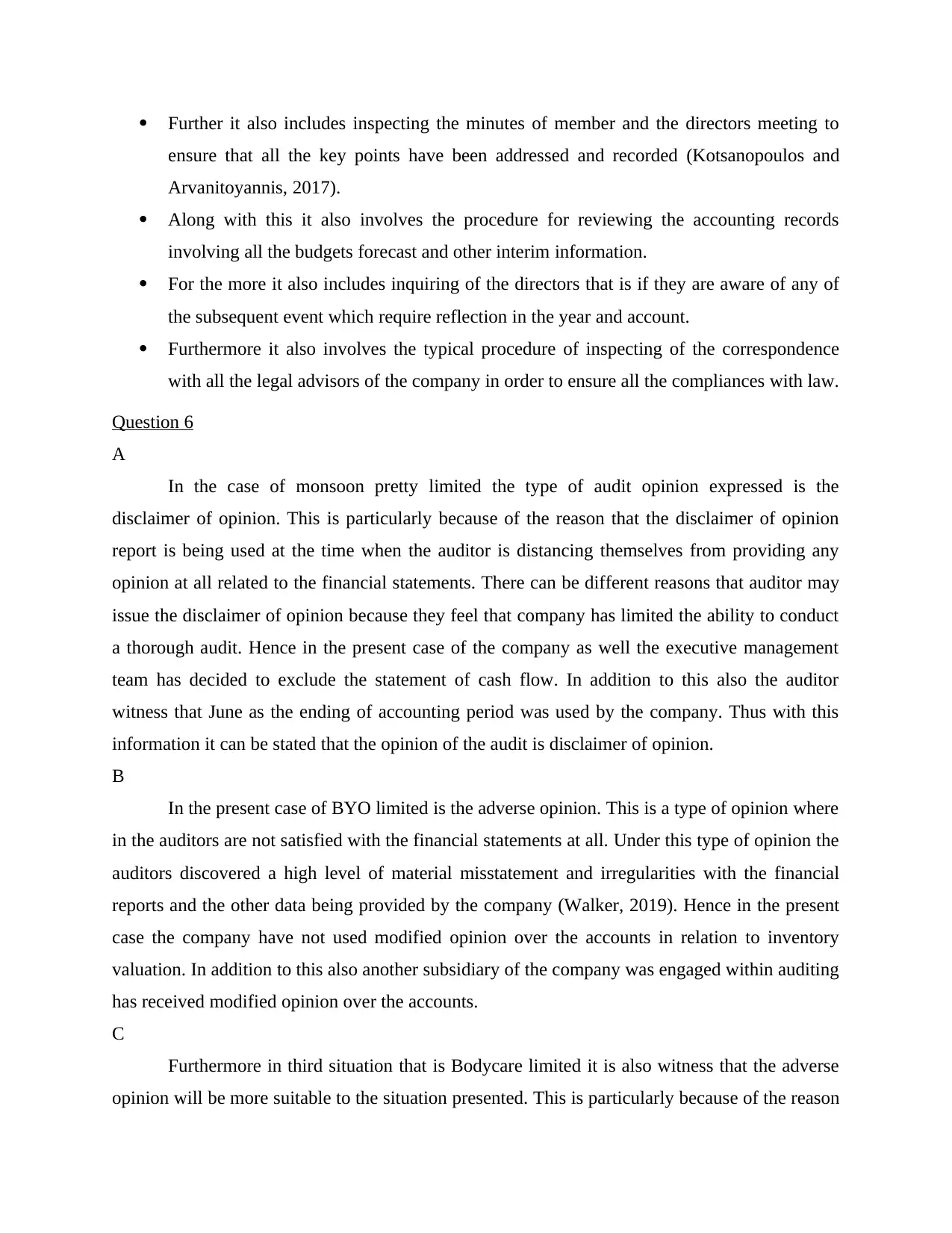
Further it also includes inspecting the minutes of member and the directors meeting to
ensure that all the key points have been addressed and recorded (Kotsanopoulos and
Arvanitoyannis, 2017).
Along with this it also involves the procedure for reviewing the accounting records
involving all the budgets forecast and other interim information.
For the more it also includes inquiring of the directors that is if they are aware of any of
the subsequent event which require reflection in the year and account.
Furthermore it also involves the typical procedure of inspecting of the correspondence
with all the legal advisors of the company in order to ensure all the compliances with law.
Question 6
A
In the case of monsoon pretty limited the type of audit opinion expressed is the
disclaimer of opinion. This is particularly because of the reason that the disclaimer of opinion
report is being used at the time when the auditor is distancing themselves from providing any
opinion at all related to the financial statements. There can be different reasons that auditor may
issue the disclaimer of opinion because they feel that company has limited the ability to conduct
a thorough audit. Hence in the present case of the company as well the executive management
team has decided to exclude the statement of cash flow. In addition to this also the auditor
witness that June as the ending of accounting period was used by the company. Thus with this
information it can be stated that the opinion of the audit is disclaimer of opinion.
B
In the present case of BYO limited is the adverse opinion. This is a type of opinion where
in the auditors are not satisfied with the financial statements at all. Under this type of opinion the
auditors discovered a high level of material misstatement and irregularities with the financial
reports and the other data being provided by the company (Walker, 2019). Hence in the present
case the company have not used modified opinion over the accounts in relation to inventory
valuation. In addition to this also another subsidiary of the company was engaged within auditing
has received modified opinion over the accounts.
C
Furthermore in third situation that is Bodycare limited it is also witness that the adverse
opinion will be more suitable to the situation presented. This is particularly because of the reason
ensure that all the key points have been addressed and recorded (Kotsanopoulos and
Arvanitoyannis, 2017).
Along with this it also involves the procedure for reviewing the accounting records
involving all the budgets forecast and other interim information.
For the more it also includes inquiring of the directors that is if they are aware of any of
the subsequent event which require reflection in the year and account.
Furthermore it also involves the typical procedure of inspecting of the correspondence
with all the legal advisors of the company in order to ensure all the compliances with law.
Question 6
A
In the case of monsoon pretty limited the type of audit opinion expressed is the
disclaimer of opinion. This is particularly because of the reason that the disclaimer of opinion
report is being used at the time when the auditor is distancing themselves from providing any
opinion at all related to the financial statements. There can be different reasons that auditor may
issue the disclaimer of opinion because they feel that company has limited the ability to conduct
a thorough audit. Hence in the present case of the company as well the executive management
team has decided to exclude the statement of cash flow. In addition to this also the auditor
witness that June as the ending of accounting period was used by the company. Thus with this
information it can be stated that the opinion of the audit is disclaimer of opinion.
B
In the present case of BYO limited is the adverse opinion. This is a type of opinion where
in the auditors are not satisfied with the financial statements at all. Under this type of opinion the
auditors discovered a high level of material misstatement and irregularities with the financial
reports and the other data being provided by the company (Walker, 2019). Hence in the present
case the company have not used modified opinion over the accounts in relation to inventory
valuation. In addition to this also another subsidiary of the company was engaged within auditing
has received modified opinion over the accounts.
C
Furthermore in third situation that is Bodycare limited it is also witness that the adverse
opinion will be more suitable to the situation presented. This is particularly because of the reason
⊘ This is a preview!⊘
Do you want full access?
Subscribe today to unlock all pages.

Trusted by 1+ million students worldwide
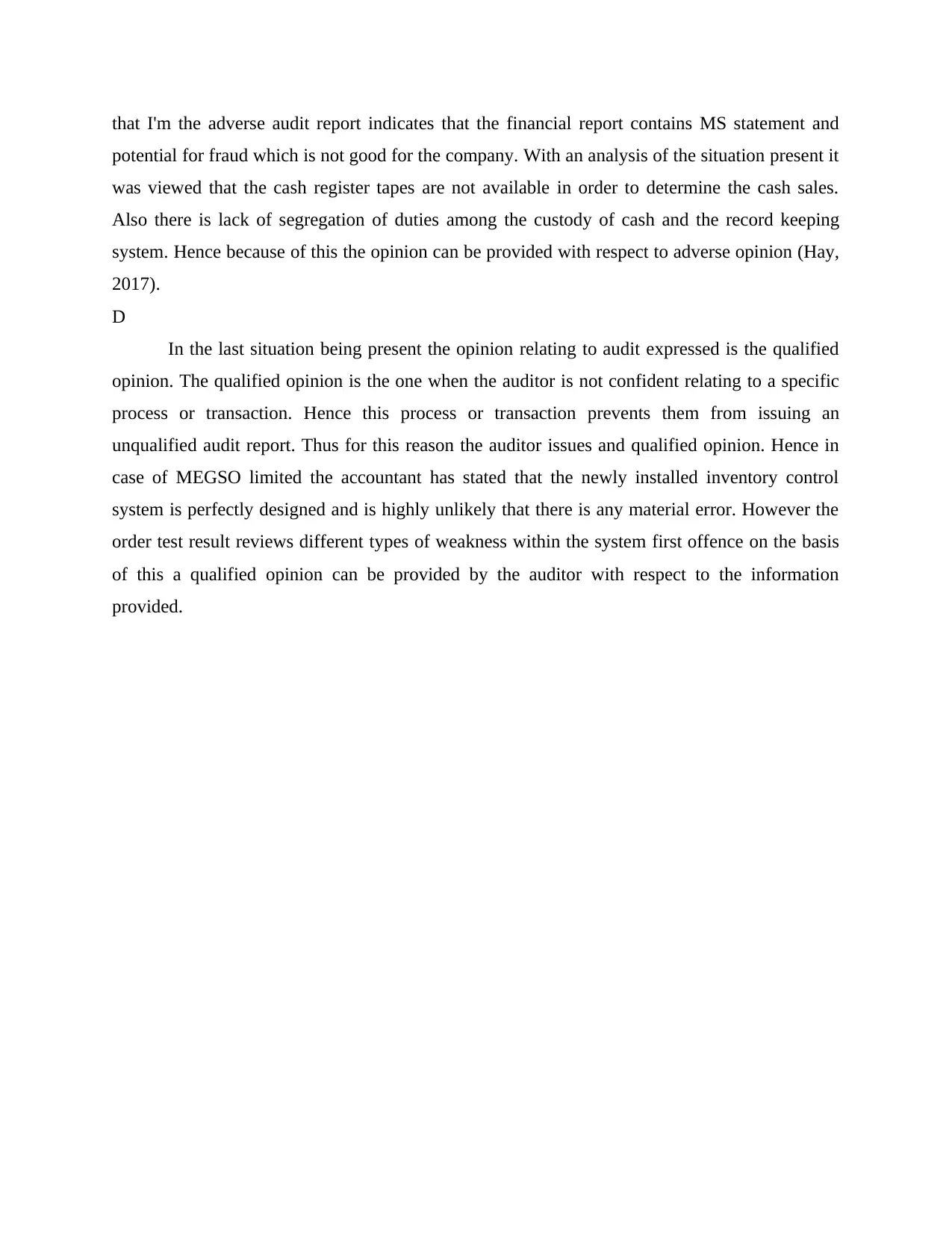
that I'm the adverse audit report indicates that the financial report contains MS statement and
potential for fraud which is not good for the company. With an analysis of the situation present it
was viewed that the cash register tapes are not available in order to determine the cash sales.
Also there is lack of segregation of duties among the custody of cash and the record keeping
system. Hence because of this the opinion can be provided with respect to adverse opinion (Hay,
2017).
D
In the last situation being present the opinion relating to audit expressed is the qualified
opinion. The qualified opinion is the one when the auditor is not confident relating to a specific
process or transaction. Hence this process or transaction prevents them from issuing an
unqualified audit report. Thus for this reason the auditor issues and qualified opinion. Hence in
case of MEGSO limited the accountant has stated that the newly installed inventory control
system is perfectly designed and is highly unlikely that there is any material error. However the
order test result reviews different types of weakness within the system first offence on the basis
of this a qualified opinion can be provided by the auditor with respect to the information
provided.
potential for fraud which is not good for the company. With an analysis of the situation present it
was viewed that the cash register tapes are not available in order to determine the cash sales.
Also there is lack of segregation of duties among the custody of cash and the record keeping
system. Hence because of this the opinion can be provided with respect to adverse opinion (Hay,
2017).
D
In the last situation being present the opinion relating to audit expressed is the qualified
opinion. The qualified opinion is the one when the auditor is not confident relating to a specific
process or transaction. Hence this process or transaction prevents them from issuing an
unqualified audit report. Thus for this reason the auditor issues and qualified opinion. Hence in
case of MEGSO limited the accountant has stated that the newly installed inventory control
system is perfectly designed and is highly unlikely that there is any material error. However the
order test result reviews different types of weakness within the system first offence on the basis
of this a qualified opinion can be provided by the auditor with respect to the information
provided.
Paraphrase This Document
Need a fresh take? Get an instant paraphrase of this document with our AI Paraphraser
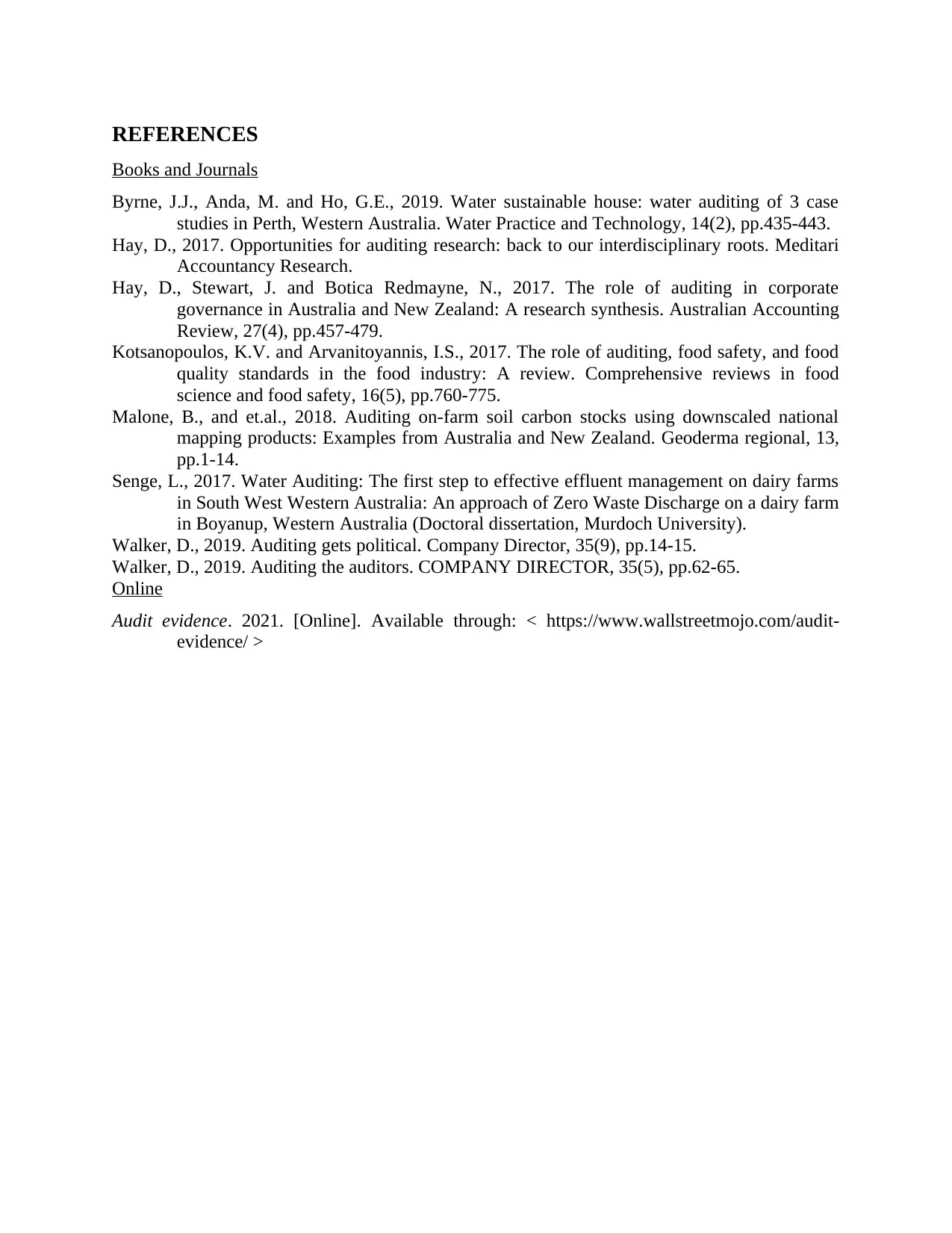
REFERENCES
Books and Journals
Byrne, J.J., Anda, M. and Ho, G.E., 2019. Water sustainable house: water auditing of 3 case
studies in Perth, Western Australia. Water Practice and Technology, 14(2), pp.435-443.
Hay, D., 2017. Opportunities for auditing research: back to our interdisciplinary roots. Meditari
Accountancy Research.
Hay, D., Stewart, J. and Botica Redmayne, N., 2017. The role of auditing in corporate
governance in Australia and New Zealand: A research synthesis. Australian Accounting
Review, 27(4), pp.457-479.
Kotsanopoulos, K.V. and Arvanitoyannis, I.S., 2017. The role of auditing, food safety, and food
quality standards in the food industry: A review. Comprehensive reviews in food
science and food safety, 16(5), pp.760-775.
Malone, B., and et.al., 2018. Auditing on-farm soil carbon stocks using downscaled national
mapping products: Examples from Australia and New Zealand. Geoderma regional, 13,
pp.1-14.
Senge, L., 2017. Water Auditing: The first step to effective effluent management on dairy farms
in South West Western Australia: An approach of Zero Waste Discharge on a dairy farm
in Boyanup, Western Australia (Doctoral dissertation, Murdoch University).
Walker, D., 2019. Auditing gets political. Company Director, 35(9), pp.14-15.
Walker, D., 2019. Auditing the auditors. COMPANY DIRECTOR, 35(5), pp.62-65.
Online
Audit evidence. 2021. [Online]. Available through: < https://www.wallstreetmojo.com/audit-
evidence/ >
Books and Journals
Byrne, J.J., Anda, M. and Ho, G.E., 2019. Water sustainable house: water auditing of 3 case
studies in Perth, Western Australia. Water Practice and Technology, 14(2), pp.435-443.
Hay, D., 2017. Opportunities for auditing research: back to our interdisciplinary roots. Meditari
Accountancy Research.
Hay, D., Stewart, J. and Botica Redmayne, N., 2017. The role of auditing in corporate
governance in Australia and New Zealand: A research synthesis. Australian Accounting
Review, 27(4), pp.457-479.
Kotsanopoulos, K.V. and Arvanitoyannis, I.S., 2017. The role of auditing, food safety, and food
quality standards in the food industry: A review. Comprehensive reviews in food
science and food safety, 16(5), pp.760-775.
Malone, B., and et.al., 2018. Auditing on-farm soil carbon stocks using downscaled national
mapping products: Examples from Australia and New Zealand. Geoderma regional, 13,
pp.1-14.
Senge, L., 2017. Water Auditing: The first step to effective effluent management on dairy farms
in South West Western Australia: An approach of Zero Waste Discharge on a dairy farm
in Boyanup, Western Australia (Doctoral dissertation, Murdoch University).
Walker, D., 2019. Auditing gets political. Company Director, 35(9), pp.14-15.
Walker, D., 2019. Auditing the auditors. COMPANY DIRECTOR, 35(5), pp.62-65.
Online
Audit evidence. 2021. [Online]. Available through: < https://www.wallstreetmojo.com/audit-
evidence/ >
1 out of 8
Related Documents
Your All-in-One AI-Powered Toolkit for Academic Success.
+13062052269
info@desklib.com
Available 24*7 on WhatsApp / Email
![[object Object]](/_next/static/media/star-bottom.7253800d.svg)
Unlock your academic potential
Copyright © 2020–2025 A2Z Services. All Rights Reserved. Developed and managed by ZUCOL.





